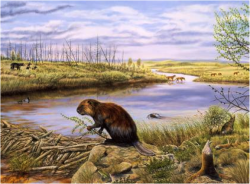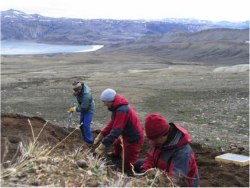A recent study indicates that ground surface temperatures in the Arctic may be more sensitive to the level of carbon dioxide (CO2) than previously thought. Using three independent proxy temperature records from an early Pliocene peat deposit in the Canadian High Arctic, investigators estimate that mean annual temperature of the paleo-arctic environment was 19°C (34°F) warmer than today. While arctic temperatures were significantly warmer during the Pliocene, CO2 levels were only slightly higher than at present. These findings indicate that arctic temperatures are highly sensitive to greenhouse gasses.
Led by a team from University of Colorado at Boulder and Principal Investigator Ashley Ballantyne, Department of Geological Sciences, this international project sought to develop robust proxy temperature indicators from the Pliocene Epoch (2.6 to 5.3 million years ago), the most recent interval in Earth's history when CO2 levels were comparable to those of today.


The three independent temperature proxies yielded mean annual temperature estimates that were statistically indistinguishable from each other, giving the investigators strong confidence in their estimates of Pliocene temperatures. The team constructed a composite mean annual temperature estimate of -0.4°C, suggesting that arctic temperatures were 19.3°C warmer during the Pliocene than they are today. These estimates are also 5-10°C warmer than previous estimates derived from temperature proxies or climate models.
The Pliocene is particularly interesting when compared with other ancient intervals of warm global mean temperatures because Pliocene atmospheric CO2 levels are estimated to have been ~390 parts per million by volume, only slightly higher than pre-industrial levels. According to Ballantyne, the findings indicate that global CO2 levels of approximately 400 parts per million by volume are sufficient to produce mean annual temperatures in the High Arctic of approximately 0°C (32°F). At this temperature it is very difficult to form and sustain perennial ice, a defining feature of the present arctic environment.
These findings suggest that current levels of atmospheric carbon dioxide may be high enough to bring about significant and irreversible shifts in arctic ecosystems. Further investigations to estimate sea surface temperature and the extent of arctic sea ice during the Pliocene could help calibrate climate models that often underestimate arctic temperatures during warm intervals.
The study, titled "The response of polar ecosystems to enhanced warming; a comparative study between modern boreal forests and Pliocene arctic forests," was funded through NSF's Office of Polar Programs at approximately $240,000, with additional support from the Natural Science and Engineering Research Council in Canada, the Polar Continental Shelf Program of Canada, the Canadian Museum of Nature, the Netherlands Organization for Scientific Research, and the European Research Council. Results are published in the July 2010 Geology: "Significantly warmer arctic surface temperatures during the Pliocene indicated by multiple independent proxies," A.P. Ballantyne et al.
For more information contact Ashley Ballantyne (Ashley.Ballantyne [at] colorado.edu), Jaelyn Eberle (Jaelyn.Eberle [at] Colorado.edu), or Natalia Rybczynski (nrybczynski [at] mus-nature.ca).
Reference A.P. Ballantyne, D.R. Greenwood, J.S. Sinninghe Damsté, A.Z. Csank, J.J. Eberle, and N. Rybczynski, 2010. Significantly warmer Arctic surface temperatures during the Pliocene indicated by multiple independent proxies: Geology 2010 v. 38, no. 7, p. 603-606 (http://geology.geoscienceworld.org/content/vol38/issue7/).
